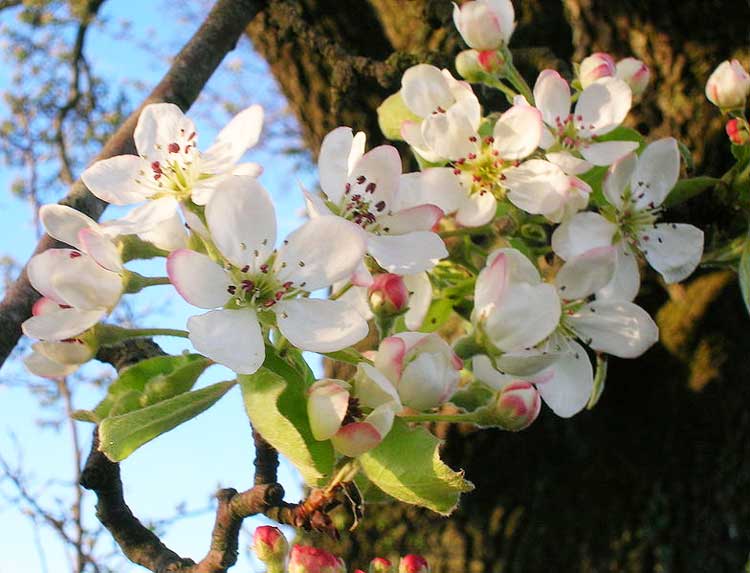
Pyrus pyraster
lassification System: APG IV
Superregnum: Eukaryota
Regnum: Plantae
Cladus: Angiosperms
Cladus: Eudicots
Cladus: Core eudicots
Cladus: Rosids
Cladus: Eurosids I
Ordo: Rosales
Familia: Rosaceae
Subfamilia: Amygdaloideae
Tribus: Maleae
Subtribus: Malinae
Genus: Pyrus
Species: Pyrus pyraster
Subspecies: P. p. subsp. achras – P. p. subsp. pyraster
Name
Pyrus pyraster (L.) Burgsd.
Synonyms
Basionym
Pyrus communis var. pyraster L., Sp. Pl. 1: 479, 1753.
References
Anleitung zur sicheren Erziehung und zweckmässigen Anpflanzung der einheimischen und fremden Holzarten 2: 193, 1787.
Linnaeus, C. 1753. Species Plantarum. Tomus I: 479. Reference page. (basionym)
Vernacular names
беларуская: Груша лясная
català: Perera borda
čeština: Hrušeň planá
Cymraeg: Coeden Ellyg Gwyllt
Deutsch: Wildbirne
dolnoserbski: Źiwa kšušcyna
English: Wild Pear
español: Peral silvestre
eesti: Mets-pirnipuu
suomi: Villipäärynä
français: Poirier sauvage
Gàidhlig: peur-fhiadhain
hornjoserbsce: Dźiwja krušwina
magyar: Vadkörte
italiano: Perastro
kurdî: Şikok
lietuvių: Miškinė kriaušė
Nederlands: Wilde peer
русский: Груша лесная
walon: Petrea
Pyrus pyraster (syn. Pyrus communis subsp. pyraster), also called European wild pear, is a species of pear of the family Rosaceae.
This wild pear and Pyrus caucasica (syn. P. communis subsp. caucasica) are thought to be the ancestors of the cultivated European pear (Pyrus communis subsp. communis). Both the wild pears are interfertile with domesticated pears.
It is sometimes difficult to distinguish Pyrus pyraster from a common pear. Pyrus pyraster can reach an age of 100 to 150 years.
Description
Pyrus pyraster is a deciduous plant reaching 3–4 metres (9.8–13.1 ft) in height as medium-sized shrub and 15–20 metres (49–66 ft) as a tree.[2] Unlike the cultivated form the branches have thorns.[2] The leaves are ovate with serrated margins. The flowers have white petals. The stamens are equal to the length of styles.[2] The flowering period extends from April through May.[2] The fruits reach 1–4 centimetres (0.39–1.57 in) in diameter[2] and ripen in late summer to early autumn. They are quite hard and astringent, but they have a sweet taste and are edible when they are very ripe and fall from the tree.[2] The seeds ripen in September.
Fruits look like a Pyrus ussuriensis var. acidula.
Under good growing conditions, wild pear trees have a remarkably slender form with a characteristic rising crown. In less favourable conditions they show other characteristic growth forms, such as one-sided or extremely low crowns.[3]
Distribution
The distribution of wild pear ranges from Western Europe to the Caucasus. It does not appear in Northern Europe.[4] The wild pear has become quite rare. It is sympatric with Pyrus elaeagrifolia.[5] It may hybridize with other pears, producing, for example, Pyrus austriaca in a cross with Pyrus nivalis.[6]
Habitat
Wild pear can grow on almost all soils, except the most acidic ones. However, owing to its weak competitive ability, the species exists mostly on extreme or marginal sites. Its tap roots enable it to grow on very dry soils. The tree requires a lot of light and is often found in the open landscape.[3] It occurs in thickets and open woods with cool-temperate climates, in lowlands, hills and sometimes in the mountains, at 0–1,400 metres (0–4,593 ft) above sea level.
Wild pears in Britain
The “wild pears” of England and Wales are actually thought to be domesticates that escaped cultivation. They appear to be archaeophytes, with charcoal and carbonised pips having been found at several Neolithic sites and are occasionally mentioned in medieval documents. It is likely that pears spread to Britain after their domestication with early farmers and subsequently escaped into the wild. Its establishment in the British Isles is probably due to human migration, with the trees belonging to one of the Pyrus communis subspecies instead of the true wild pear species of P. pyraster, which is native to much of continental Europe but absent from Britain.
Another species of pear found wild in South West England, the Plymouth pear (Pyrus cordata), is now thought to have originated from hedging plants imported from Brittany.
Notes
The Plant List
Pignatti S. - Flora d'Italia – Edagricole – 1982. Vol. I, pag. 603
Stephan, B.; Wagner, I. & Kleinschmit, J. (2003), Wild apple and pear - Malus sylvestris/Pyrus pyraster: Technical guidelines for genetic conservation and use (PDF), EUFORGEN: European Forest Genetic Resources Programme, archived from the original (PDF) on 2016-10-20, retrieved 2017-01-19
Schede di Botanica
Hanelt, Peter; Büttner, R. (2001). Mansfeld's Encyclopedia of Agricultural and Horticultural Crops. Berlin: springer-Verlag. p. 465. ISBN 3-540-41017-1.
Sansavini, Silviero (2002). Proceedings of the VIIIth International Symposium on Pear. Ferrara-Bologna, Italy: International Society for Horticultural Science. pp. 191–192.
References
Biolib
Edward Milner – Trees of Britain and Ireland, page 113 - regarding Pears in Britain.
Retrieved from "http://en.wikipedia.org/"
All text is available under the terms of the GNU Free Documentation License

